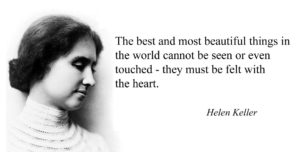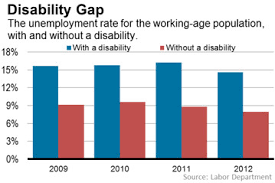Orientation and Mobility
In addition, the child who is deaf-blind will need help learning to move about in the world. Without vision, or with reduced vision, he or she will not only have difficulty navigating, but may also lack the motivation to move outward in the first place. Helping a young child who is deaf-blind learn to move may begin with thoughtful attention to the physical space around him or her (crib or other space) so that whatever movements the child instinctively makes are rewarded with interesting stimulation that motivates further movement. Orientation and mobility specialists can help parents and teachers to construct safe and motivating spaces for the young child who is deaf-blind. In many instances children who are deaf-blind may also have additional physical and health problems that limit their ability to move about. Parents and teachers may need to include physical and occupational therapists, vision teachers, health professionals, and orientation and mobility specialists on the team to plan accessible and motivating spaces for these children. Older children or adults who have lost vision can also use help from trained specialists in order to achieve as much confidence and independence as possible in moving about in their world.
Individualized Education
Education for a child or youth with deaf-blindness needs to be highly individualized; the limited channels available for learning necessitate organizing a program for each child that will address the child’s unique ways of learning and his or her own interests. Assessment is crucial at every step of the way. Sensory deficits can easily mislead even experienced educators into underestimating (or occasionally overestimating) intelligence and constructing inappropriate programs.
Helen Keller said, “Blindness separates a person from things, but deafness separates him from people.” This potential isolation is one important reason why it is necessary to engage the services of persons familiar with the combination of both blindness and deafness when planning an educational program for a child who is deaf-blind. Doing so will help a child or youth with these disabilities receive an education which maximizes her or his potential for learning and for meaningful contact with her or his environment. The earlier these services can be obtained, the better for the child.
Transition
When a person who is deaf-blind nears the end of his or her school-based education, transition and rehabilitation help will be required to assist in planning so that as an adult the individual can find suitable work and living situations. Because of the diversity of needs, such services for a person who is deaf-blind can rarely be provided by a single person or agency; careful and respectful teamwork is required among specialists and agencies concerned with such things as housing, vocational and rehabilitation needs, deafness, blindness, orientation and mobility, medical needs, and mental health.
The adult who is deaf-blind must be central to the transition planning. The individual’s own goals, directions, interests, and abilities must guide the planning at every step of the way. Skilled interpreters, family members and friends who know the person well can help the adult who is deaf-blind have the most important voice in planning his or her own future.
Inclusion in Family
Clearly, the challenges for parents, teachers and caregivers of children who are deaf-blind are many. Not least among them is the challenge of including the child in the flow of family and community life. Since such a child does not necessarily respond to care in the ways we might expect, parents will be particularly challenged in their efforts to include her or him. The mother or father of an infant who can see is usually rewarded with smiles and lively eye contact from the child. The parent of a child who is deaf-blind must look for more subtle rewards: small hand or body movements, for instance, may be the child’s way of expressing pleasure or connection. Parents may also need to change their perceptions regarding typical developmental milestones. They can learn, as many have, to rejoice as fully in the ability of their child who is deaf-blind to sign a new word, or to feed herself, or to return a greeting as they do over another child’s college scholarship or success in basketball or election to class office.
Parents, then, may need to shift expectations and perceptions in significant ways. They also need to do the natural grieving that accompanies the birth of a child who is disabled. Teachers and caregivers must also make these perceptual shifts. Parents’ groups and resources for teachers can provide much-needed support for those who live and work with children and adults who are deaf-blind. Such supports will help foster the mutually rewarding inclusion of children who are deaf-blind into their families and communities. (See section below for resources.)
Summary
Though deaf-blindness presents many unique challenges to both those who have visual and hearing impairments and to their caregivers and friends, these challenges are by no means insurmountable. Many persons who are deaf-blind have achieved a quality of life that is excellent. The persons who are deaf-blind who have high quality lives have several things in common.
First, they have each, in their own way, come to accept themselves as individuals who have unique experiences of the world, and valuable gifts to share. This fundamental acceptance of self can occur regardless of the severity of the particular sensory losses or other challenges that a person has. Second, they have had educational experiences which have helped them maximize their abilities to communicate and to function productively. Finally, these happy, involved persons who are deaf-blind live in families, communities, or social groups that have an attitude of welcoming acceptance. They have friends, relatives, and co-workers who value their presence as individuals with significant contributions to make to the world around them. For these persons with limited sight and hearing, and for those near them, deaf-blindness fosters opportunities for learning and mutual enrichment.

